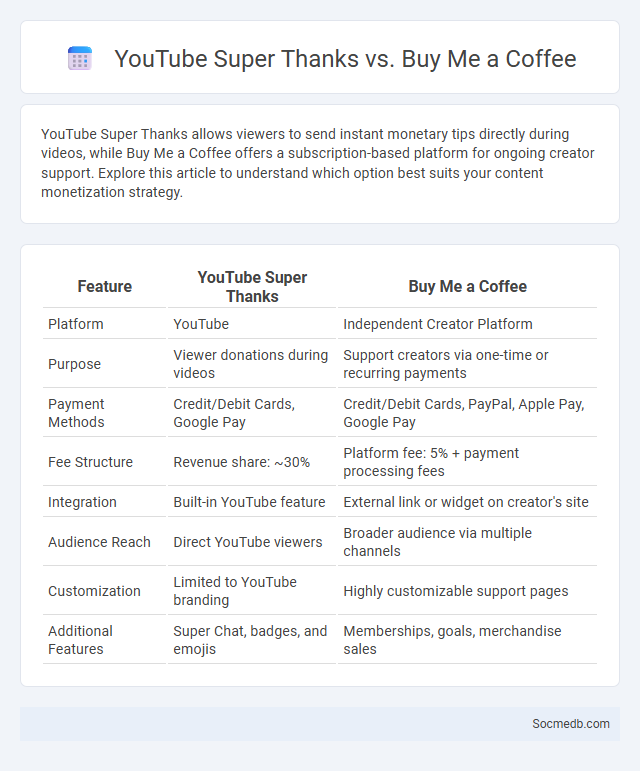
Photo illustration: YouTube Super Thanks vs Buy Me a Coffee
YouTube Super Thanks allows viewers to send instant monetary tips directly during videos, while Buy Me a Coffee offers a subscription-based platform for ongoing creator support. Explore this article to understand which option best suits your content monetization strategy.
Table of Comparison
| Feature | YouTube Super Thanks | Buy Me a Coffee |
|---|---|---|
| Platform | YouTube | Independent Creator Platform |
| Purpose | Viewer donations during videos | Support creators via one-time or recurring payments |
| Payment Methods | Credit/Debit Cards, Google Pay | Credit/Debit Cards, PayPal, Apple Pay, Google Pay |
| Fee Structure | Revenue share: ~30% | Platform fee: 5% + payment processing fees |
| Integration | Built-in YouTube feature | External link or widget on creator's site |
| Audience Reach | Direct YouTube viewers | Broader audience via multiple channels |
| Customization | Limited to YouTube branding | Highly customizable support pages |
| Additional Features | Super Chat, badges, and emojis | Memberships, goals, merchandise sales |
Overview of YouTube Super Thanks
YouTube Super Thanks is a fan funding feature that allows viewers to directly support creators by purchasing animated gratitude messages on videos. This functionality enhances creator-audience interaction and provides an additional revenue stream beyond ads and memberships. By enabling your fans to make monetary contributions with personalized messages, Super Thanks strengthens community engagement on your channel.
Introduction to Buy Me a Coffee
Buy Me a Coffee is a monetization platform designed to help creators, artists, and influencers generate income through direct support from their audience. Users can receive one-time payments or monthly memberships, enabling sustainable revenue streams without relying solely on advertising. This platform integrates seamlessly with social media channels, enhancing creator-audience engagement and financial empowerment.
Understanding Fan Funding Platforms
Fan funding platforms like Patreon and Ko-fi enable creators to receive direct financial support from their audience, fostering a sustainable income stream. These platforms offer tiered membership options, exclusive content, and real-time interaction opportunities, enhancing fan engagement and loyalty. By leveraging fan funding, creators can bypass traditional ad revenue models and build a dedicated community focused on content quality and personalized experiences.
Key Features Comparison
Social media platforms differ significantly in their key features, with Facebook emphasizing extensive user interaction through groups, events, and a versatile news feed, while Instagram prioritizes visual content sharing via Stories and Reels. Twitter specializes in real-time updates with concise posts and trending hashtags that facilitate rapid information dissemination. LinkedIn focuses on professional networking, offering tools such as endorsements, job postings, and industry-specific content to connect businesses and professionals effectively.
Monetization Options for Creators
Social media platforms offer diverse monetization options for creators, including ad revenue sharing, brand sponsorships, affiliate marketing, and fan memberships. Features like YouTube's Super Chats, Instagram's Shopping tags, TikTok's Creator Fund, and Patreon's subscription services enable creators to generate income directly from their audience and partnerships. Leveraging these monetization methods enhances revenue streams, audience engagement, and long-term brand growth for digital content creators.
Audience Engagement and Interaction
Social media platforms enhance audience engagement by facilitating real-time interaction through comments, likes, and shares, which increase content visibility and brand loyalty. Interactive features like polls, live videos, and stories foster deeper connections by encouraging user participation and feedback. Analyzing engagement metrics such as click-through rates, comments per post, and time spent on content helps optimize strategies for targeted audience growth.
Fees and Payout Structures
Social media platforms vary widely in their fees and payout structures, often charging transaction fees on earnings or subscriptions. Your revenue share depends on the platform's specific policies, with some offering a higher percentage of ad revenue or tip payouts to content creators. Understanding these financial frameworks is essential for maximizing your income and planning sustainable growth.
Pros and Cons of Each Platform
Facebook offers extensive user reach and robust advertising tools, making it valuable for businesses targeting diverse demographics, but its algorithm changes can reduce organic visibility and raise privacy concerns. Instagram excels in visual content and influencer marketing, ideal for brands focused on lifestyle and aesthetics, yet it often demands high-quality imagery and can foster unrealistic comparisons. Twitter provides real-time news and direct engagement opportunities, yet its character limits and fast-paced feed can hinder detailed communication and increase exposure to misinformation. Understanding these pros and cons helps You choose the best platform aligned with Your goals and audience.
Choosing the Best Fan Funding Solution
Selecting the best fan funding solution depends on factors like platform fees, integration with social media channels, and audience engagement features. Popular options include Patreon, Ko-fi, and Buy Me a Coffee, each offering unique tools to monetize content effectively while maintaining a strong connection with supporters. Evaluating payment options, customization capabilities, and analytics can optimize revenue streams and enhance fan interaction on social media.
Final Thoughts and Recommendations
Optimizing social media strategies requires consistent engagement, targeted content, and data-driven analytics to maximize reach and audience interaction. Prioritizing platform-specific algorithms and utilizing trending hashtags significantly boost visibility and community growth. Regularly updating content quality and monitoring performance metrics ensures sustained relevance and effective brand communication.
 socmedb.com
socmedb.com